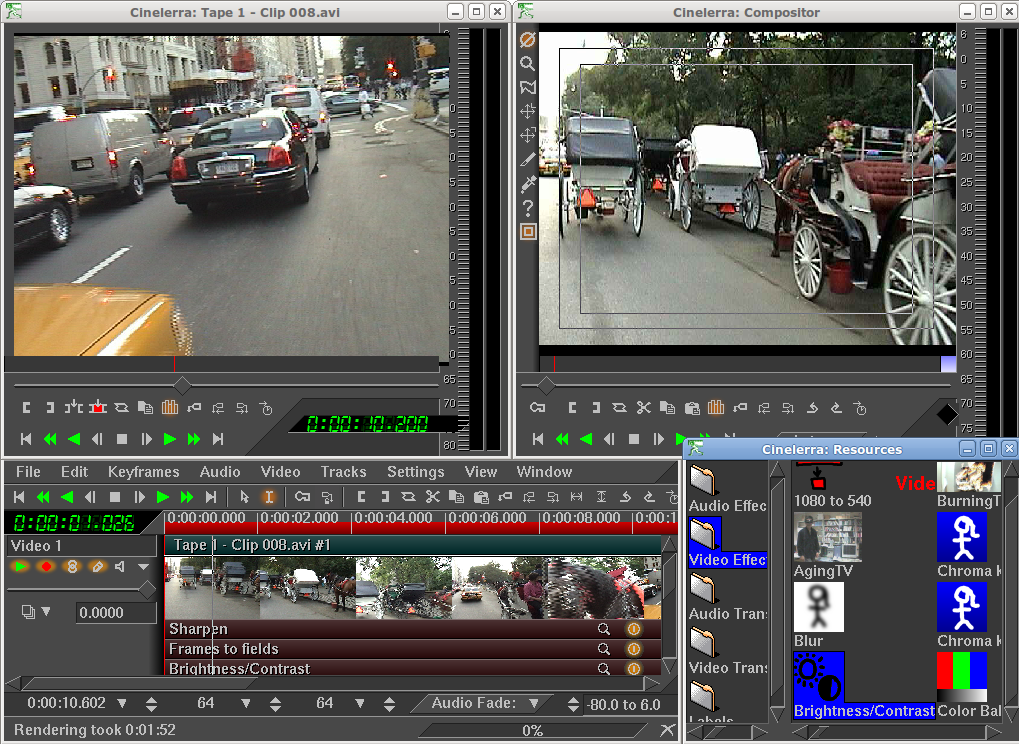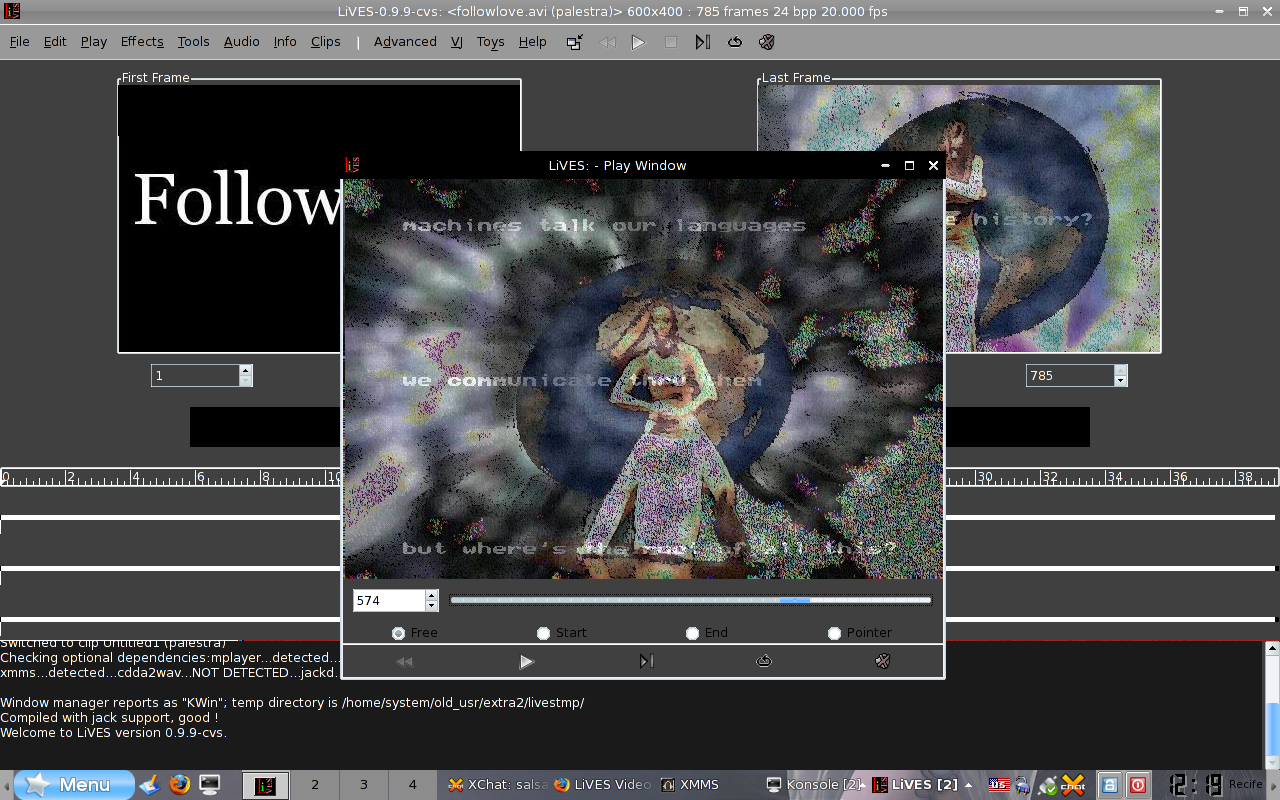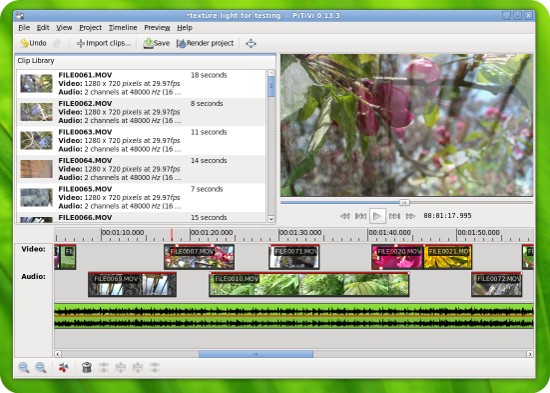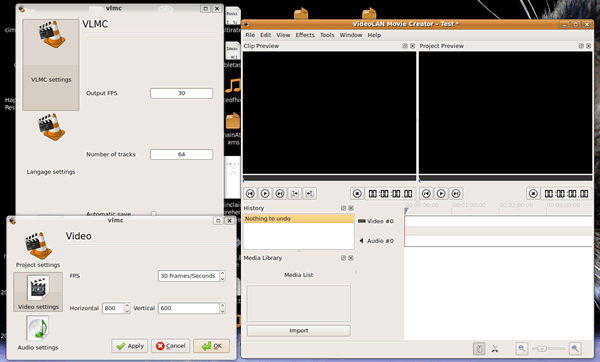 Come visto in un precedente articolo sull’audio esistono molti ottimi tool open source per realizzare soluzioni professionali.
Come visto in un precedente articolo sull’audio esistono molti ottimi tool open source per realizzare soluzioni professionali.
Oggi voglio fare una carrellata sulla parte di Video editing ed indicarvi alcuni tra i migliori software open source disponibili per Linux per fare video editing.
Se ne conoscete altri, segnalatemelo nei commenti.
OpenShot
Kino
Cinellera
Lives
Kdenlive
Pitivi
VideoLan Movie Creator
Openshot
“Ho una missione semplice: creare un editor video non-lineare open-source, per Linux. Molti hanno provato e fallito prima di me, ma per qualche motivo mi sento in dovere di provarlo io stesso. Sto documentando il mio viaggio in questo blog che tutti potranno leggere. Sarà un viaggio pericoloso, e potrei non tornarne vivo. Tenetevi stretti, e godetevi il viaggio! A proposito, sto chiamando questo progetto OpenShot Video Editor! “
Questo il messaggio iniziale pubblicato nel maggio 2008, ed ora Openshot è uno tra i più rispettati ed appezzati software per il video editing
OpenShot Video Editor è un software libero di montaggio video non lineare per il sistema operativo Linux. Il progetto è stato iniziato ad agosto 2008 da Jonathan Thomas.
È sviluppato in linguaggio Python, utilizza il toolkit GTK+ e il framework MLT, lo stesso utilizzato dal programma analogo Kdenlive.
Openshot screencast
Ottimi link:
http://jeffhoogland.blogspot.com/2010/03/linux-video-editing-with-openshot.html
http://fosswire.com/post/2009/08/openshot-video-editing-made-simple/
http://en.wikipedia.org/wiki/OpenShot_Video_Editor
Kino
Kino è un software basato su GTK+ è un editor non lineare di video digitale. E’ distribuito come software libero. La sua visione è: “Facile e affidabile editing DV per il desktop Linux con esportazione in molti formati utilizzabili.” Il programma supporta molti aspetti basilari di video editing e le attività di montaggio.
Con Kino è possibile importare prime file AVI e DV, così come catturare filmati da videocamere digitali utilizzando le librerie raw1394 dv1394, ed esportare a videocamere con le librerie video1394 ed ieee1394.
Kino è incluso nel repository pubblico di diverse distribuzioni GNU / Linux, tra cui Debian. BSD ports sono inoltre disponibili.
Video editing con Kino
vedi anche
http://www.softpedia.com/reviews/linux/Kino-Review-49269.shtml
Cinellera

Cinelerra è un completo ambiente di produzione audio e video per Linux.
Cinelerra è un sistema di editing video non-lineare. È progettato per il sistema operativo GNU/Linux. È prodotto da Heroine Virtual, ed è software libero distribuito sotto la GNU General Public License. Cinelerra include anche un motore di compositing video, permettendo all’utente di effettuare le normali operazioni di composizione come il keying e mattes.
Cinelerra è stato rilasciato il 1 Agosto 2002, e si è basato in parte su un prodotto in precedenza noto come Broadcast 2000. Broadcast 2000 è stato ritirato da Heroine Virtual nel settembre 2001.
Cinelerra include il supporto per audio e video ad alta fedeltà : elabora audio usando 64 bit di precisione, e può funzionare sia in spazi di colore RGBA che YUVA, utilizzando la virgola mobile e rappresentazioni di interi a 16 bit, rispettivamente. E’ risoluzione e frame rate indipendente, nel senso che può supportare video di qualsiasi velocità e dimensioni.
Video course on using Cinellera:
Lives
LiVES è iniziato nel 2002 come Linux Video Editing System. Dal momento che ora gira su più sistemi operativi: LiVES è un Video Editing System. È stato progettato per essere semplice da usare, ma potente. E’ di piccole dimensioni, ma ha molte funzionalità avanzate.
LiVES mescola performance in tempo reale di video e di editing non lineare in una applicazione di qualità professionale. Ti consente di iniziare a modificare e fare video da subito, senza doversi preoccupare di formati, dimensioni della struttura, o framerate. Si tratta di uno strumento molto flessibile che viene utilizzato sia da VJ’s professionisti e da editori video – mescolare e passare clip dalla tastiera, decine di effetti in tempo reale, regola e modifica i tuoi filmati nell’editor di clip, e mettili insieme utilizzando la multitraccia basata sul tempo. Potete persino registrare le vostre prestazioni in tempo reale, e quindi modificarle ulteriormente o salvarle immediatamente.
Per i più dotati tecnicamente, l’applicazione è precisa per frame e sample, e può essere controllata da remoto o da script per l’utilizzo come server video. E supporta tutti i più recenti standard aperti.
Kdenlive
Kdenlive è un intuitivo e potente video editor multi-traccia, che comprende le tecnologie video più recenti.
Il software è un video editor open-source per GNU/Linux e FreeBSD, che supporta DV, HDV e AVCHD.
Kdenlive si basa su diversi progetti open sourcei, come ad esempio FFmpeg, MLT video framework e gli effetti Frei0r .. Usare Kdenlive è investire in un progetto guidato dalla comunità, che mira a stabilire relazioni tra persone al fine di costruire il migliore strumento per il video.
An Intro to Video Editing with Kdenlive Part 1: Installing Kdenlive and Walkthrough
PiTiVi
Con l’avvento di Ubuntu 10.04 questo software è entrato di default tra i programmi video presenti nel sistema. Basato sul framework GStreamer, PiTiVi è davvero molto facile da imparare ed apprendere grazie alla sua interfaccia attentamente progettata per soddisfare sia il nuovo arrivato sia il professionista.
Supporta moltissimi formati e potete trovare nella home una lista completa di tutte le sue caratteristiche.
Free ed Open Source.
PiTiVi non chiederà mai soldi per licenze o ti bloccherà dall’accedere ai tuoi filmati con qualche DRM, PiTiVi è distribuito sotto licenza LGPL.
VideoLan Movie Creator
Videolan Movie Creator è un software libero di editing video multi-piattaforma, alimentato dal famoso VideoLan Client (VLC). Può girare su Windows, Mac OS X e Linux e fornisce molte funzioni che si trovano negli editor di filmati professionali.
Il progetto è relativamente nuovo essendo nato nell’ambito del Google Summer of Code 2010
Popular Posts:
- None Found




Blender has a very powerful movie editor built into it.
I’ve seen some using Blender for video editing… though for more complex stuff.
Avidemux should be on this list. It’s a linear editor (similar to VirtualDub) but for simple editing, such as cutting commercials out of a TV show, resizing, cropping, etc., it’s hard to beat it. The learning curve is also much smaller than with a NLE.
@PAT:
Avidemux should maybe be expected if only looking at the title of the post. After reading the contents and seeing only NLE’s introduced, it’s hard to say linear editors should be on the list as well.
Then again, the scope is quite broad, running from PiTiVi to Cinerella.
Why do you show a screen shot of Open Movie Editor and leave it out?
Congrats in be the only one seeing it.
I’ve kept OME for a follow up article, but i liked that screen shot so i used it in this article.
The greatest problem with linux video editing is:
a. Some software is not very stable, kdenlive is an example for a very crash prone program.
b. Programs are very basic or ultra complex, see iMovie on the mac for a sample of how it should be done.
c. Documentation is VERY lacking.
In fact my wife tried to do video editing on linux, just to give up. We got a mac and we are happy. Graphics and sound editing is great on linux but video is awful.
While this is a nice “here’s what’s available” article, it doesn’t tell the reader why anyone would want to use one app over the other, what situations X or Y app excels in, any of that. Such information would be helpful.
For example, I use Kdenlive for all my videos. Why? Because it was in the Ubuntu repositories and does the job. But what does LiVES do better than Kdenlive? Where does Kino excel, or not do so well? And can they read each other’s project file formats? This kind of info would be good to know.
Take care,
–SYG
I can help focus the line between “here’s what’s available” and “here’s what it does.” I once used Cinelerra for a video project and was amazed by its powerful video editing and compositing capabilities. I thought I have found true love (whereas before I was stuck with crappy old Windows Movie Maker) when I discovered that Blender had not only an excellent video sequence editor but also an extremely flexible video compositor as well. I have since switched to Blender for my amateur movie making workflow, but both programs have excellent capabilities.
A word to the wise, though, and to answer Yair Carel: Both programs required diligent online documentation/forum/tutorial reading on my part. I once used iMovie and thought it a brilliant video editing software until I discovered how disappointingly little it had to offer for compositing scenes except for a few shrink-wrapped special effects (which have since been removed).
So, to answer SYG, Blender and Cinelerra are powerful programs that can accomplish everything from simple splicing and cropping to complex special effects, but they might not be as out-of-the-box intuitive as LiVES, Kino, Kdenlive, etc. But for those who are willing to learn, the Blender/Cinelerra power couple have a lot of professional level features and flexibility to offer, no fine-arts graduate diploma required. These big-boy tools don’t have very many shrink-wrapped special effects to offer, but the key is that you get to make them yourself. Once you learn how, which isn’t hard, the possibilities are endless.
To me it seems like Blender has more documentation/troubleshooting forum support. Cinelerra seemed to have a little appearance and frustration instability at first, but you gotta google the forums for either tool when you run into problems. Meanwhile, with these two in my bag, I no longer have to worry about who’s-better-at-what between PiTiVi, Kino, Kdenlive, LiVES, and those millions of others.